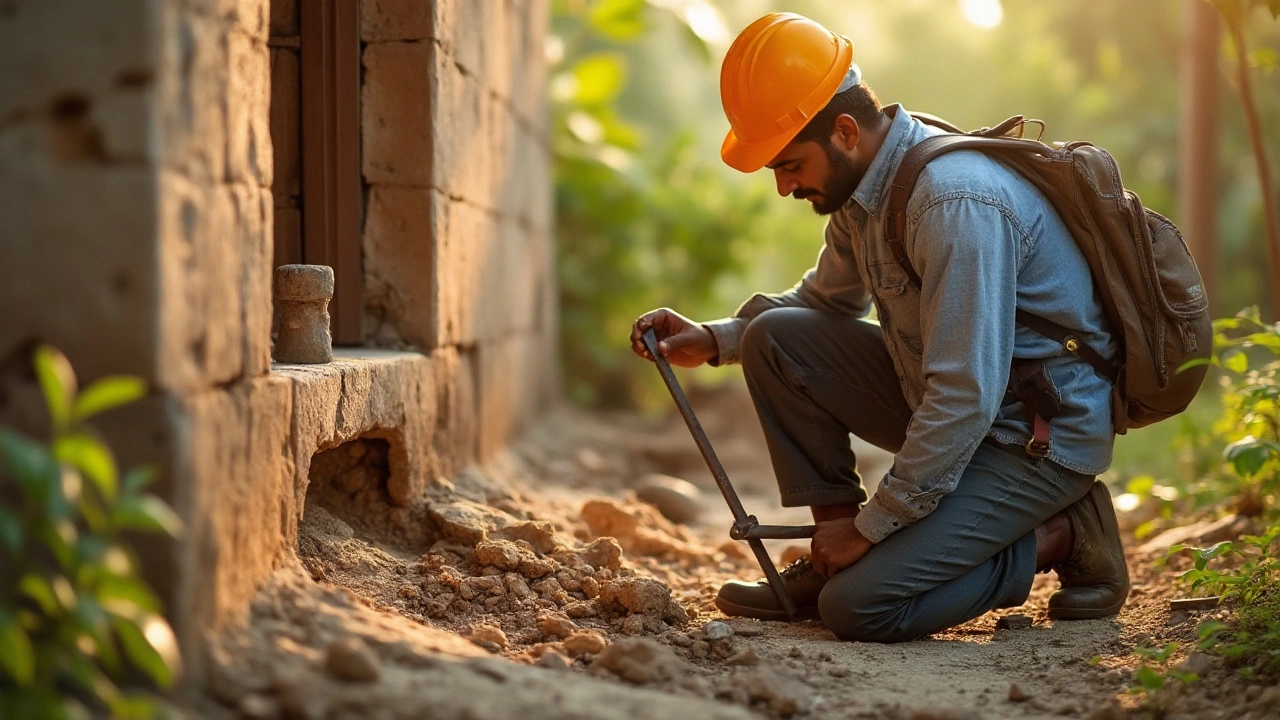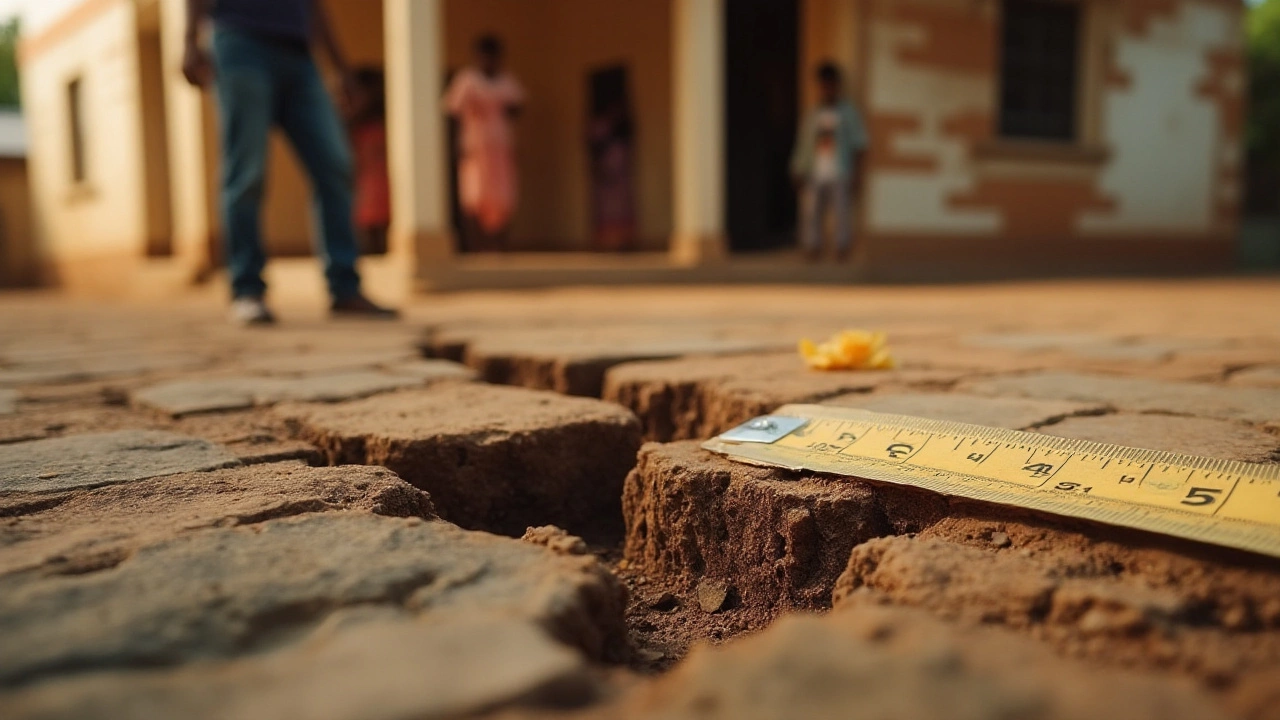Imagine sitting in your living room, sipping a warm cup of coffee, while a subtle crack snakes its way along the wall beneath you. It's not uncommon; many homes develop foundation cracks over time. But how do you know if those cracks are the simple result of settling, or a looming threat to your home’s very structure?
Cracked foundations are more widespread than one might think and can occur for any number of reasons—from natural settling and soil conditions to poor construction practices. The key is to determine whether the crack is harmless or a harbinger of more significant structural issues.
While the sight of a foundation crack can understandably set homeowners on edge, not all cracks signal impending disaster. So how do you know when it's time to roll up your sleeves and call in the experts for repairs? Understanding the different types of cracks, their potential causes, and the risks associated with each can make all the difference in maintaining a safe home.
- Understanding Foundation Cracks
- Signs of Trouble and When to Worry
- Immediate Steps for Homeowners
- Repair Options and Costs
Understanding Foundation Cracks
In the realm of house foundation complexities, it's essential to distinguish the different types of cracks and their underlying causes. Most homeowners encounter cracks that run the gamut from hairline to quite substantial. Understanding these variations can spell the difference between routine maintenance and urgent intervention. Generally, foundation cracks can be categorized into three types: horizontal, vertical, and diagonal. Each type speaks a different language of what might be happening beneath your home. Horizontal cracks often suggest a more serious problem, potentially indicating issues with water pressure or even soil expansion placing undue stress on your foundation's walls. Vertical cracks tend to signify normal settling, typically of less concern unless they widen over time. Diagonal cracks might occur due to differential settlement when one section of the foundation sinks more than another.
Every case is unique, so it's vital to examine the width, location, and progression of the crack. Experts have long suggested that cracks wider than 1/4 inch often warrant a closer look, as they might point to possible structural issues. Beyond the type and size, the material of your foundation plays a role too. For instance, poured concrete foundations are known to develop vertical cracks as part of the curing process, which may not be structurally significant. Concrete block foundations might showcase stair-step cracking patterns. Understanding the symptoms helps guide decisions on whether to watch the situation or take immediate action. As Henry David Thoreau wisely observed,
"It is not what you look at that matters, it is what you see."This notion holds particularly true when assessing the state of your foundation.
In many urban areas where historical homes abound, a foundation crack may be an intrinsic feature of aged architectural designs. Such properties can exhibit various cracks, detailed in records referencing their structural behaviors over time. An intriguing study conducted by the American Concrete Institute highlighted how 25% of homes built before the 1930s displayed at least one significant foundation crack. These insights present a stark reminder to actively monitor and assess any new or existing cracks through regular inspections. Whether living in a bustling city with an old-world charm or a freshly minted suburb, maintaining vigilance over your foundation repair needs is just part of modern homeownership.
An important tool in a homeowner's arsenal is the establishment of baseline measurements for any cracks that appear. With the use of simple instruments like rulers or crack monitors, you can track changes over time. Documenting the evolution of a crack offers valuable data that can be shared with structural engineers or foundation specialists if the need arises. Remember, taking proactive steps and understanding the intricacies of a cracked foundation might save substantial costs in the long run and safeguard the home safety you cherish.

Signs of Trouble and When to Worry
It’s important to differentiate between cracks that are mere aesthetic nuisances and those demanding urgent intervention because of potential significant impact. Not all foundation cracks indicate that your house is on the verge of collapse, but some do mark the beginnings of serious trouble. Recognizing these early symptoms can save you both money and a good deal of anxiety down the road.
First, observe the direction of the crack. Horizontal cracks are often considered more concerning than their vertical counterparts. Horizontal fissures may suggest serious issues with the soil pressure outside your foundation wall. Such pressure might push the wall inward, compromising the house's structural integrity. Vertical cracks, however, are often due to natural settling and can be less ominous. Next, examine the width. As a rule of thumb, a crack wider than a quarter of an inch ought to raise alarms. It might not seem extravagant, but a small gap can easily widen over time, leading to water infiltration, pests, and further structural instability.
Any evidence of stair-step cracks in brick exteriors could be another red flag. When these patterns appear, it typically signifies uneven settling, with parts of the foundation sinking or heaving more than others. This might not be visible immediately but monitoring over time is crucial. When alarm bells ring, pay attention to other unsettling signs within the home itself such as sticking doors or windows, sloping floors, or cracks above doors and windows inside the house. Such symptoms align closely with *foundation repair* needs.
Damage escalation could also be paired with other indicators such as large wall gaps or bulging walls, often heralding more serious structural difficulties. These concerns aren’t just cosmetic. Left unchecked, they could significantly impact a home's value. “If you notice diagonal cracks in your foundation emanating from the corners of your doors or windows, it’s time to call in the experts,” claims Robert Sareca, a structural engineer with over two decades of experience in foundation analysis.
“The sooner you identify and address the root causes, the greater the likelihood of preserving the integrity of your home.”
Beyond visual checks, consider enlisting a professional for a precise evaluation if you find anything troubling. They can provide reliable insights into whether you're facing a natural settling issue or an immediate *foundation repair* crisis. Remember, proactive measures and addressing foundational anomalies early can save substantially on potential expensive repairs and ward off additional home value depreciation. What might seem like a daunting task initially is often much more manageable when tackled early, providing you peace of mind, as well as a safer, more secure home environment.

Immediate Steps for Homeowners
Finding a crack in your home’s foundation can be unsettling, but knowing what steps to take next can provide reassurance and perhaps even prevent further damage. It’s important for every homeowner to approach this situation with a calm and methodical plan, as not every crack will spell disaster, yet prompt action may be required. First, begin by cataloging the cracks in your house foundation. This means both interior and exterior walls should be assessed. Use a ruler or another measuring device to record their width and length. Try to note whether the crack seems to increase, which often suggests ongoing movement in the foundation.
Once you have a record of the cracks, consider aiming for a short-term monitoring phase. For at least a month, keep track of these cracks to gather effective data on their evolution. This involves making marks at the ends of the cracks and measuring their growth weekly. If you notice any significant changes, that’s your cue to start thinking about foundation repair. Many experts, like those at HomeAdvisor, suggest this simple monitoring technique as a layperson's tool for distinguishing between serious concerns and superficial issues.
“Not all foundation cracks are created equal. Understanding that distinction is crucial,” advises Andrew Clapham, Structural Engineer and author of "Foundations 101."
While keeping an eye on the cracks, homeowners should also look out for other warning signs. These could be windows or doors that have begun sticking, uneven floors, or cracks larger than a quarter-inch wide. If these accompany your foundation cracks, it often suggests a more serious issue that should be addressed by professionals sooner rather than later. It’s crucial not to panic, but to be responsive.
While monitoring can reveal many issues, sometimes a more hands-on approach is advisable. Some quick fixes can prevent issues from worsening before professional help arrives. If there is a visible gap along edges where your home structure meets the foundation, filling these with expandable sealant can be a temporary buffer protecting against moisture intrusion, especially in wetter climates. This is not a substitute for professional evaluation but serves as a stopgap solution to minimize potential secondary problems.
If the cracks exist in a humid or rainy region, additional measures against water accumulation should be considered. Luckily, common techniques like ensuring proper trench placements can be done by homeowners without specialized skills. Check downspouts and ensure they direct water away from the house, using extenders if needed. Grading the land so it slopes away from the foundation can prevent water from pooling near the house. An effective water management strategy ensures the soil surrounding the home maintains its positive natural pressure, instead of coming loose and causing foundation shifts.
To reinforce this proactive approach, here’s a brief checklist to aid you through those early days of finding foundation cracks:
- Document visible cracked foundation areas with measurements.
- Monitor crack progression over a few weeks for significant changes.
- Look for additional symptoms, such as during or after rainfall events.
- Apply expandable sealant to the immediate gaps if applicable.
- Re-assess water drainage pathways near the house foundation.
Taking these immediate steps can significantly help in stabilizing and preserving the structural integrity of your home until you can secure professional support leading to a comprehensive solution.

Repair Options and Costs
When it comes to addressing a cracked foundation, it's essential to know that like any ailment, the right treatment varies greatly depending on the diagnosis. Repairing a crack in a home’s foundation can range from simple and straightforward to rather complex, impacting both cost and technique. The first step in this complex journey is often a detailed inspection, preferably by a specialist, who can pinpoint the specific causes and the extent of the damage. Therein lies the first cost—determining the scope of the problem, as this may run from free estimates to a few hundred dollars. This vested capital is crucial, ensuring the longevity and safety of one’s humble abode.
One common method of repair for less severe cracks, often those less than a quarter-inch wide, is epoxy injections. This process involves injecting a special resin into the cracks to seal them, thus restoring the integrity of the foundation. An epoxy injection works well for preventing moisture intrusion and stopping minor cracks from spreading further. This service can typically cost between $500 to $1,000, depending on the size and accessibility of the crack. But what about larger or more significant fractures? Here’s where the complexity increases, alongside the repair cost. Foundation underpinning, a method of strengthening and stabilizing the foundation, is often used for major issues. It might involve adding piers beneath the home, a process that digs deep down to find stable soil. Underpinning is not a small investment, with typical costs anywhere from $1,000 to $3,000 per pier, and a single home may require multiple piers.
For those grappling with extensive damage or water-related issues, waterproofing the basement can be an additional consideration. This process might involve adding interior or exterior drains, sump pumps, or additional sealing. While this doesn't directly fix the cracks, it can prevent future water damage and stabilize the foundation. Costs for this work range widely from $2,000 to over $10,000, based on the required interventions. As the saying goes, an ounce of prevention is worth a pound of cure. Regular inspections and maintenance can help catch potential issues before they escalate, saving homeowners both headaches and hefty future expenses.
Sometimes it’s beneficial to hear from those players on the field, seasoned experts who have navigated the murky waters of foundation repair.
"Foundation repairs are investments in your home's future," says Patrick Brown, a respected civil engineer who has worked on countless structural issues. "It's about ensuring safety and preserving value. Skipping necessary repairs can lead to much costlier interventions and reduced property value down the road."This perspective highlights the importance of seeing foundation repair not just as a cost, but as a pivotal long-term investment.
For homeowners, it's vital to balance the critical need to repair with the financial implications these repairs can bear. In some cases, exploring financing options or negotiating payment terms with contractors can make the difference in affording necessary work. Homeowners may also inquire with insurance companies, as certain policies may cover some of the repair costs under specific circumstances. Understanding and exploring all available options is key to making the best decisions for a home's lasting health and stability.

Written by Fletcher Abernathy
View all posts by: Fletcher Abernathy